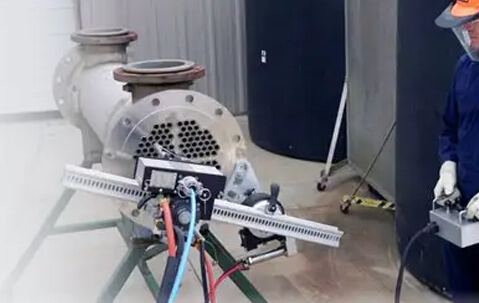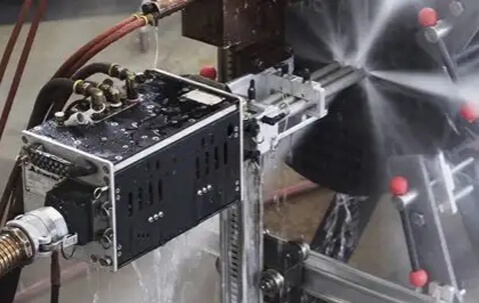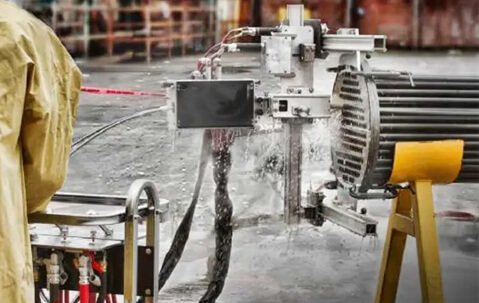In the industrial sector, the maintenance of heat exchangers has always been a critical and challenging task. The advent of high-pressure water automatic cleaning systems has revolutionized this field, offering unparalleled efficiency and precision.
Heat exchangers are indispensable in industries such as petroleum, chemical, thermal power, and metallurgy. However, during operation, the inner walls of their densely packed pipe networks are prone to scaling and fouling.

These deposits not reduce heat transfer efficiency but also increase energy consumption and even pose safety risks like leaks or explosions .
Traditional cleaning methods, such as manual scrubbing or chemical cleaning, are often inefficient, time-consuming, and potentially damaging to the equipment. Chemical cleaning also carries the risk of environmental pollution and requires careful handling of corrosive agents .
The Core Advantages of High-Pressure Water Automatic Cleaning Technology
High-pressure water automatic cleaning technology utilizes the impact force of high-velocity water jets to remove scale, dirt, and other deposits from heat exchanger pipes.
This method eliminates the need for chemical solvents, making it an environmentally friendly solution that avoids secondary pollution . The automated operation ensures thorough cleaning without damaging the equipment substrates .
The key advantages of this technology include:
High Efficiency: Significantly reduces cleaning time compared to manual methods.
Precision Cleaning: Automated systems can target specific areas without missing spots or repeating.
Safety: Reduces the need for human exposure to hazardous environments.
Cost-Effectiveness: Lowers operational costs and minimizes downtime.

System Composition and Working Principle
A typical automatic cleaning device consists of several core components:
A high-pressure pump system that pressurizes water
Automated positioning devices (e.g., multi-axis robotic arms)
Rotating nozzles that deliver the high-pressure jets
Vision systems or sensors for pipe positioning and inspection
Control systems for managing the cleaning process
The working principle involves pressurizing ordinary water through a high-pressure pump and delivering it through specialized nozzles. The conversion of high-pressure, low-velocity water into low-pressure, high-velocity jets creates impact energy that exceeds the adhesion force of deposits, effectively removing them from pipe walls .
Advanced systems incorporate machine vision positioning technology and multi-axis robotic structures to achieve precise nozzle alignment and automated operation without human intervention .

Application Cases Across Industries
High-pressure water automatic cleaning technology has proven effective across various sectors:
Thermal Power Plants:
DI 350/23EM high-pressure cleaning machines can achieve 95% descaling rate on heat transfer surfaces without causing damage or corrosion. This significantly improves heat exchange efficiency and reduces energy consumption .
Nuclear Power Facilities:
Using DP 280/74EM models for cleaning titanium alloy heat exchangers prevents sludge deposition and corrosion issues, ensuring operational stability .
Oil Refineries:
DP 500/38EM equipment effectively removes stubborn deposits from heat exchange equipment, crucial for maintaining process efficiency and reducing costs .
Paper Mills:
DP 400/45EM systems can clear scale buildup in evaporators and pipelines, which often reaches several millimeters thick and can completely block pipes if left untreated .

Economic Benefits and Environmental Advantages
The adoption of automatic high-pressure water cleaning systems brings substantial economic benefits:
Reduced Operational Costs:
One heat supply company reported saving ¥800 per heat exchanger compared to chemical cleaning methods, totaling over ¥100,000 annually across their operation .
Extended Equipment Lifespan:
Regular cleaning can extend the service life of heat exchangers by 3-5 years on average by preventing corrosive damage .
Minimized Downtime:
Automated systems can complete cleaning in 50% less time than traditional methods, with some systems allowing for online cleaning without shutdowns .
Environmental benefits include:
Zero chemical pollution from cleaning operations
Reduced water consumption through precise application
Compliance with environmental standards such as ISO 14001


Please contact us for free quotation by form below. We promise the quickest response within 24 hours: